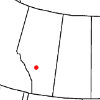
West Central Alberta Coldest, wettest edge | We have very variable soils and drainage, with the result that hay stands end up equally variable, especially after a few wet years, such as right now. Anything with good drainage, or really rich soil grows alfalfa really well, with timothy, orchard grass etc doing well along side. The lowest spots with deep black soil will grow grass, timothy, or native equally well. The really tight, poorly drained clay, will maybe grow alfalfa for a year or 3, will grow clover like crazy for a year or 2, then might not grow much of anything except timothy, and mediocre at that, depending on the year and the weather. Alsike and dutch clover will volunteer to grow anywhere, but don't generally amount to much. All this and more within a few acres and a few feet of elevation. This all ends up as beef cow hay, where quanitity is generally more important than quality, within reason. A single cut per year, cows usually take the second cut. Yeilds vary from under a ton per acre to 6, with 3 being quite typical.
The timothy responds to N, but the N is a waste where the alfalfa grows well. The typical hayland blend here is equal parts N P K and S. Which is an expensive way to get the N to the grass. I've done some feilds in pieces, some with a blend of N P ,k and S, some with pure N. The last couple of years, hay has been such a poor price and fertilizer so expensive that very little hay has been fertilized, and that is really showing up this year. I did fertilize some mostly grassy hay with N this year, looks like I might get my money back, and what has been 2 years without is really showing it, looking like next year will have to bite the bullet and replace some borrowed nutrients, probably at cheaper prices finally.
I know the answer is to get all the acres to grow alfalfa, and all the problems will solve themselves( compaction, lack of N, waterlogged soils, and dried out soils etc.) but that is easier said than done, and is a work in progress. We do get the rainfall to make fertilizing hay a worthwhile proposition, but the economics don't always make sense. So how do you fertilize variable stands? Is feeding legumes N a complete waste of money, or is there a benefit? What percent of a stand has to be a legume for it to provide enough N for the rest of the stand? I've always assumed that once there is less than an alfalfa plant per square foot it is likely not contributing enough to be worthwhile, or am I wrong? With recent high grain prices, and really high land prices, hay has to carry its own weight, not like a few years ago when we could put up with a mediocre hay crop with few inputs.
Edited by Alberta Farmer 7/16/2013 18:18
|


 How do you fertilize mixed hay in variable stands?
How do you fertilize mixed hay in variable stands?